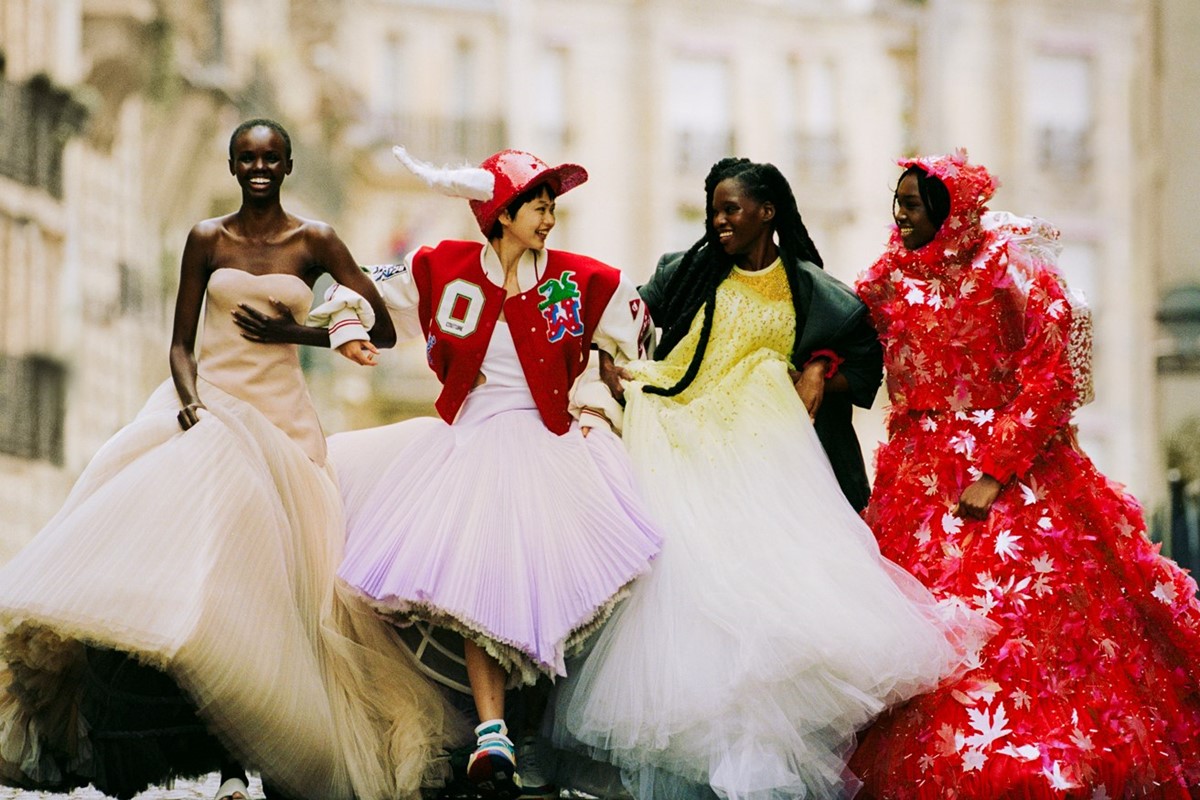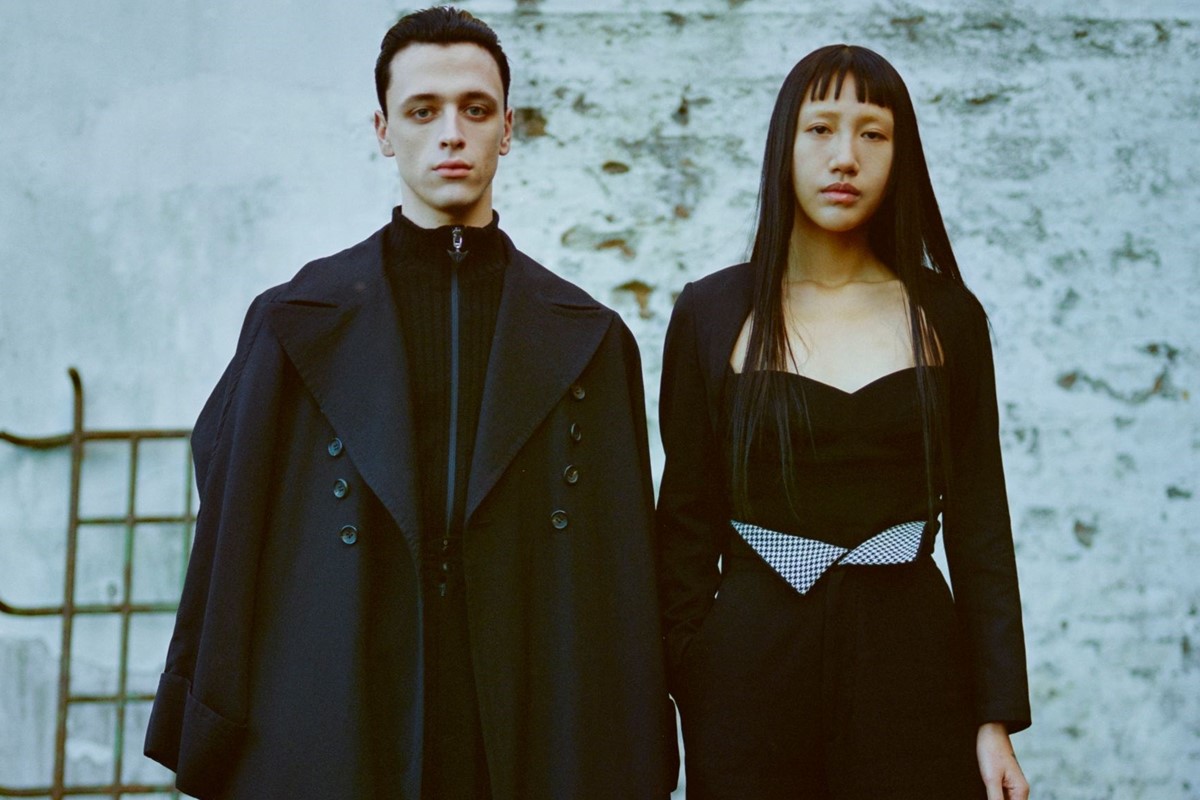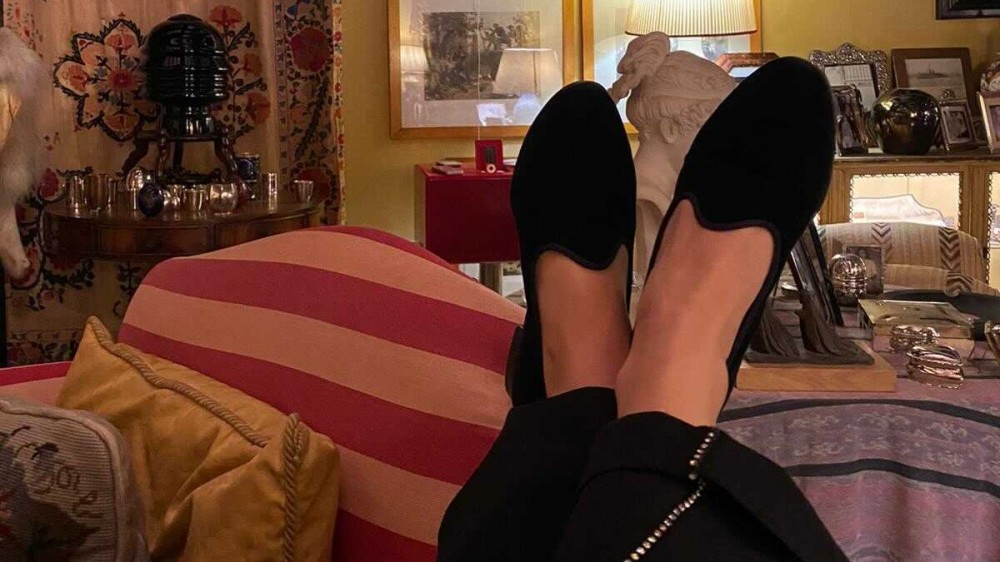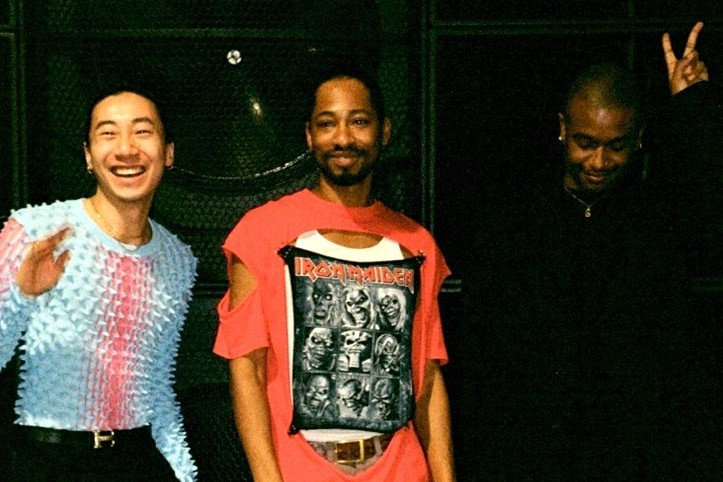
A brief history of bootleg fashion
From Dapper Dan to Balenciaga, we chart the unstoppable rise to relevance of the oft-misunderstood bootleg culture
Taken from the summer 2022 issue of Dazed. You can buy a copy of our latest issue here.
Join Dazed Club and be part of our world! You’ll get a free subscription to Dazed for a year and behind-the-scenes access to our editors, plus discounts on events, museums and festivals. Join for £5/month today.
Fashion bootleg has been around forever. As long as brand obsession has existed, so has the drive to update, collage and appropriate its symbols. But in the last decade, bootleg has become the industry’s favourite way to explore the boundaries of high and low cultures. It has grown to reflect the ways that fashion hierarchy is disrupted and reinvented.
I spent most of 2019 working on an exhibition called The Real Thing at Fashion Space Gallery in London. It was dedicated to bootleg as a creative language and disruptive force. Among the works of 13 artists and designers were May Hands’ sculptures, created by pouring concrete into luxury shopping bags; Hassan Kurbanbaev’s photos from markets in Uzbekistan, locals proudly posing in velvet robes and tracksuits emblazoned with LV and Gucci logos; and Ancuta Sarca’s kitten heels made from upcycled Nike trainers. At the centre of the display, there was a metal fence which served to display a selection of garments from Tottenham-based label Sports Banger. My highlight was an elegantly tailored pair of trousers and elbow-length gloves in fabric patterned with blue-and-white NHS logos.

The generic definition of bootleg is something that is “made, distributed, or sold illegally”. Bootleg fashion, as opposed to straightforward fakes, often implies a level of artistic appropriation or interpretation. In looking for the essence of its creative energy, people often turn to the work of Daniel Day AKA Dapper Dan, the legendary fashion designer and “Harlem couturier” who reinvented the monograms of luxury European houses like Louis Vuitton and Gucci for the crowd of New York City hustlers and hip-hop legends, including Eric B & Rakim, Salt-N-Pepa, LL Cool J and Jay-Z.
In his 2019 memoir Made in Harlem, Day recalls the moment he first glimpsed the power of luxury branding. A customer walked into his shop, and a crowd quickly gathered around his companion, attracted by a little brown leather clutch in her hands. The bag had a repeated pattern of gold letters – an L overlapping a V. Riding on the excitement of the moment, the designer had an idea to create a whole leather outfit covered in LV monograms. He’d spent the previous few years selling fur coats and luxury leathers, but using the monogram promised to unlock a new level of chic for Harlem’s streets. He jumped in his car and drove to a Louis Vuitton store on Fifth Avenue to investigate further.
“The drive to the Louis Vuitton store was only a couple [of] miles, but it was a world away from Dapper Dan’s boutique. I was the only Black person in there, and I felt the place tense up when I walked in. The doorman’s eyes never left me. No wonder none of my customers like to spend their money down here,” he writes. “I ignored the unwelcome reception to study the merchandise. Approaching the owners of a brand like this and asking them to partner with me was out of the realm of possibility, even though the clothes in my shop were just as expensive and well made as the ones down here. I’d had a hard enough time getting far smaller white-owned companies to work with me. If I couldn’t be trusted to walk around their store, how could I be trusted to sell their clothes?”
Day ran his original boutique in Harlem from 1982 until 1992. He first specialised in reselling leather and furs before moving on to create unique outfits from monogrammed leather. He invented a unique process of screen-printing leather in his studio, which allowed him to craft jackets, dresses and even car upholstery with Gucci, Louis Vuitton and MCM logos. His designs soon attracted a sizeable following. Eric B & Rakim wore Dapper Dan’s designs on the cover of their iconic albums Paid in Full and Follow the Leader. Mike Tyson was a customer. The attention, however, was not only positive – the store attracted lawsuits from luxury brands for unauthorised use of their monograms and police raids confiscating the “counterfeit”, eventually leading to its closure.
In 2017, Day was back in the spotlight on the high of fashion’s interest in the bootleg. Following director Alessandro Michele’s homage to a well-known Dapper Dan 1989 puffy-sleeve dress for athlete Diane Dixon, the designer started an official partnership with Gucci. This was only a year before Virgil Abloh was appointed as artistic director for menswear at Louis Vuitton. Dapper Dan’s first visit to the Vuitton store seems worlds away from the moment Abloh cried at the finale of his first Louis Vuitton show in 2018, yet they’re parts of the same story. It is a story about desire and branding, about the real and the fake, about groundbreaking talent, blackness, style and self-determination. It is also a story about fashion’s neverending obsession with hierarchy: the highs, the lows and the disruptors.
In fact, Day never referred to his creations as bootlegs or knock-offs. “I did knock-ups. I took brand symbols and did things with them that those brands weren’t even thinking of, and I made it for our culture,” he once said. He never imitated existing designs – he reinvented the luxury symbols for his community. He created entirely new shapes, silhouettes and colour combinations, incorporating the stories and experiences of his peers in his designs. Virgil Abloh’s work possessed the same gravitas: he recontextualised and remixed to create new modes of self-expression for those around him.

With a background in architecture, Abloh started his fashion journey from an internship at Fendi alongside Kanye West. When they got photographed outside a Comme des Garçons show in Paris in 2009, Abloh in a Moncler puffer gilet, West clutching a Goyard briefcase, it channelled the same outsider energy Dapper Dan might have had walking through the doors of the Fifth Avenue boutiques. They radiated confidence and vigour, emblems of wealth worn like armour. The palpable energy of a status symbol stayed in Abloh’s work until the end – but instead of using the symbols of historical luxury houses, he started off by creating his own.
For his first fashion project, Pyrex Vision, Abloh used deadstock Ralph Lauren flannels which he printed with a Pyrex logo and the number 23 (after Michael Jordan’s famed basketball shirt). The garment itself was relatively unimportant: instead, the product was all about owning a slice of Abloh’s creative energy. Pyrex flannels were a canvas, a readymade of sorts, a statement of being in-the-know available for $550. Sharing the name with basic glass cookware, the brand only existed for a year, despite having a cult following.
At Off-White, Abloh turned red zip tags and quotation marks into ultimate signifiers of hype. He even tried (unsuccessfully) to trademark them – his own version of a monogram. Quotation marks went around everything, simultaneously subverting the object’s meaning and amplifying its value. Is it a bag or is it a ‘sculpture’? When meeting fans, Abloh would sign trainers and T-shirts with a thick black marker pen putting quotation marks around random words and sometimes his own name. The way his touch and his mark made the object more valuable was transparent. In a way, it both exposed and disrupted the hierarchy of branding – four strokes of a black marker pen seemed too easy to be priced and valued that high.
The debate of value, realness and authenticity in fashion is never just about the label – it is about voices, representation and what kind of communities get to be included. Abloh was a son of immigrant parents from Ghana, which, he told Dazed in 2019, meant that his stellar rise in fashion was seemingly “impossible, you know? Like, categorically not gonna happen in a lifetime”. Yet there are others who are smudging the social hierarchy of race and class through the language of fashion. Mexican American designer Willy Chavarria has carved out a space representing the beauty of immigrants, first-generation Americans and the diverse Latinx movement. USA t-shirts in his collections are a nod to Latinx obsessions with American brands like American Eagle, True Religion and Nike. These garments serve as a mirror for the community to see itself. Chavarria’s work is often looked at as a subversion of American style, a bootleg of sorts – while what he represents are, actually, the real voices and faces of today’s America.
“I used the NHS logo in my fashion show despite problems with the government because I am a bootlegger. Being a bootlegger means doing what you want” – Jonny Banger
In the mid-2010s, fashion bootleg had its moment. It was the language of irony – at times sardonic, at times self-critical, at times political. In the era of hype culture, it was necessary: the whole generation had grown up trading overpriced sweatshirts in the “Basement” Facebook group, branded cotton suddenly a source of status, culture and community. Bootleg would surprise you, make you laugh, stop and think – an ultimate winner in the attention economy. Demna Gvasalia made the Vetements logo visually rhyme with Champion, and Balenciaga did the same with Bernie Sanders’ presidential campaign. In 2016, Vetements held a garage sale in Seoul, South Korea, for a one-off The Original Fake collection, and Gucci collaborated with graffiti artist GucciGhost, who applied his appropriated spray-paint motif as well as the slogan “Real” to a number of items. From 2016 to 2020, HypePeace collective bootlegged the Palace logo to raise money for Palestine.
“Some said that my NHS Nike t-shirt was a comment on commercialisation and privatisation of the NHS,” says Jonny Banger of Sports Banger label of their wildly popular tee. “The NHS is free; the NHS with a Nike tick is £19.99. Read it however you want. I used the NHS logo in my fashion show despite problems with the government because I am a bootlegger. Being a bootlegger means doing what you want. Start where you are, use what you’ve got, do what you can.”
The Real Thing exhibition closed in March 2020, with the onset of the Covid-19 pandemic. Banger spent the following month selling t-shirts and hoodies to raise money for the NHS, making roughly £100,000 for the delivery of healthy meals to ICU workers and community centres during the pandemic. If there was ever a political meaning to bootleg, there it was. The pandemic has undeniably changed our lives forever. We have witnessed the world in a state of emergency – mostly through the screens of our mobile devices and laptops. In this context, fashion had to acquire new meanings. Irony was no longer an option. For the first time in decades, there was no one there to observe branded handbags and sunglasses – with no IRL audience, the allure of branding has lost a part of its magic.
Moreover, we had time to reconsider what it is we’re looking for from fashion in times of crisis. Emotion, joy, hope? Something which takes your breath away? Something visceral, even if observed through the computer screen? The search for a new kind of elegance started before the pandemic, but the time in isolation showed that this was perhaps what we craved to be reminded of seductive textures and excessive romantic visions. The Off-White AW20 collection possessed just that: the Arc’teryx gown, an impractical, over-the-top vision in white tulle with a sleeve of a blue windbreaker. The elegance that we love today is inherently subversive. It echoes Abloh’s Louis Vuitton men’s leather harnesses or his plastic bag-covered stilettos for Jimmy Choo. It has absorbed the energy of the riot – it’s by no means quiet or conformist.

One of the brightest emerging designers and the newly appointed creative director of Salvatore Ferragamo, Maximilian Davis, is a good example. His vision of Black elegance is bold and sharp like a knife. It cuts through time: into the past when Black designers couldn’t see themselves in the works of Cristóbal Balenciaga, or celebrating carnival in Trinidad as the deepest manifestation of freedom. The black feather headpiece from the SS21 collection worn by Naomi Campbell is elegance as power, elegance as victory.
Since the appointment of Demna Gvasalia as creative director in 2015, Balenciaga has been the epitome of an elegance which emerged from the era of bootlegs, oversized hoodies and shows in dingy club basements – not the aesthetic, but the inquisi- tive, gritty spirit. We have seen the giant cylindrical hats, the coats sewn together from shiny black feathers, the gowns which double up as voluminous down jackets. But most importantly, the beauty that Gvasalia creates is filtered through his own complex personal history, including his experiences as a war refugee.
For the Balenciaga AW22 catwalk show, Gvasalia paid tribute to those affected by the ongoing war in Ukraine. The show opened with the designer reading a dedication to resistance by Ukrainian poet Oleksandr Oles, who died on the run from the Nazis in 1944. On every seat was a yellow-and-blue t-shirt, along with a note. “The war in Ukraine has triggered the pain of a past trauma I have carried in me since 1993, when the same thing happened in my home country, and I became a forever refugee.”
In a glass rotunda similar to a giant snowglobe, models trekked through a snowstorm in high heels. Some wore large jackets, some long dresses, some outfits which were seemingly constructed from layers of tape. Many carried heavy bags with them, as if on the move. The long train of Eliza Douglas’s blue dress dragging in the snow: exactly the kind of personal and political membrane that fashion seems to exist inside today. We see the beauty of draping, the expressive power of proportions, the slender high heels – all the fine luxurious details Gvasalia has finessed during his stellar career in fashion. All of this thrown into the whirlwind, making us question: what is the purpose of high fashion when the world is on fire?
The notion of hierarchy has always been integral to fashion but, as the last decade has shown, the hierarchy is crumbling. The high and the low, the real and the fake are not so easily distinguished any more. The meanings of these once-oppositional notions are yet to be reinvented, both IRL and in the emerging world of digital fashion. We have to accept that on this journey we all have to be both tourists and purists to truly comprehend it.
Hair AKEMI KISHIDA at MA+TALENT using ORIBE, make-up VANESSA BELLINI at MA+TALENT using BYREDO, models AKIMA at OUI, VYKRONELIA at PREMIUM, ZOE at SYSTEM, GABRIEL and SEKHOU at ROCKMEN, CÉDRIC at ELITE PARIS, photographic assistants PIERRE NOWAK, QUENTIN FARRIOL, styling assistants GLORIJA GZIMAILAITE, hair assistants CLOTILDE LAISNÉ, YULIA PANTIUKHINA, make-up assistants CLARA BARBAN DANGERFIELD, XIAOYUAN YANG, digital assistant ANTOINE BERNARD, production LAURA FORREST and RACHEL LEQUESNE at DIVISION, production assistants RÉMI CROQUET, THOMAS NÉAUME, casting IKKI CASTING



